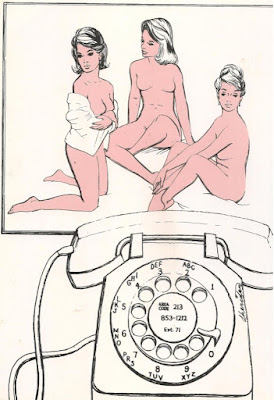 |
| Suddenly, I'm nostalgic for rotary phones. |
NOTE: This article continues my coverage of Angora Fever: The Collected Short Stories of Edward D. Wood, Jr. (BearManor Bare, 2019).
 |
| The full artwork. |
The story: "Dial-A-Vision," originally published in Black and White, vol. 2, no. 2, June/July 1972. Credited to "Dick Trent."
Synopsis: Convicted felon Harry Tomas is leaving prison after 15 years. He had killed three women with his car while very drunk. He's convinced the authorities had it in for him because he'd been a bookmaker and pimp. He's also obsessed with inventions and learning how things work, especially telephones. In prison, his fantasy life had revolved around contacting beautiful women through the telephone wires. Once on the outside, Harry secures a room in the cellar of a flophouse and begins working on an invention of his own. After many months of hard work, he builds a giant telephone through which the user can actually contact women and interact with them physically through a giant, jelly-like screen. Harry tries the invention himself and passes through the screen, but what he finds on the other side is not what he was expecting.
Wood trademarks: Character named Harry Tomas (Harry is not only one of Ed's most-used male character names, cf. "Mice on a Cold Cellar Floor," but also similar to Harry Thomas, makeup man for Ed's early movies); character named Shirley (cf. Necromania, Orgy of the Dead); "broads" (cf. "Wanted: Belle Starr," "Mice on a Cold Cellar Floor"); heavy drinking (cf. "To Kill a Saturday Night," "Never Fall Backwards"); streetwalkers (cf. Orgy of the Dead, "The Hooker"); fur (cf. "Never Fall Backwards"); cellar (cf. "Mice on a Cold Cellar Floor"); fluff (cf. "The Fright Wigs"); caskets (cf. "Into My Grave"); eternity (cf. "Time, Space and the Ship").
Excerpt: "There were whores to be laid. There were whores to be organized. In all of those terrifying, confining fifteen years there wasn’t one time when he hadn’t thought about the whores he had once organized and handled. And every time he'd mentally dialed that telephone and watched the screen it was one of the girls he had known who was performing the action for him."
 |
| Rod Serling on The Twilight Zone. |
I can't honestly say what Ed Wood's artistic motivations were, but he did occasionally use science-fiction as a way to explore (read: sugarcoat) some sensitive topics. Take Glen or Glenda (1953), for instance, in which he uses Bela Lugosi's mysterious "Spirit" character -- part god, part mad scientist -- to frame a film about gender issues. And then there's Plan 9 from Outer Space (1959), which has zombies, aliens, graveyards, and flying saucers, all in service of a parable about the escalating arms race.
Interestingly, in 1957, Ed tried and failed to launch his own anthology show, Portraits in Terror. The title actually suggests one of Rod Serling's later series, Night Gallery. Eddie only managed to film one episode of the TV show, so we can only imagine what the rest of Portraits in Terror would have been like. I think "Dial-A-Vision" would have made a fine installment. Here we have an unredeemed sinner, Harry, as our protagonist. At the outset of the story, he seems to feel no remorse for the terrible thing he's done, plus he seems to be a paranoid-obsessive type. Anyone who's ever seen The Twilight Zone or Night Gallery (or Tales from the Crypt for that matter), knows that this guy has some ironic punishment in his near future. And, sure, that's basically what happens. But Eddie has a singularly bizarre way of getting there.
(I mean, seriously, Ed, what was up with the jelly?)
P.S. Incidentally, this story was originally accompanied by artwork -- proudly signed by an artist named Sheriden -- depicting a giant rotary telephone with the number (213) 853-1212 printed in the center of the dial. For decades, this was the number that folks in Southern California would call to hear a recorded voice telling you the time of day. AT&T finally put a stop to the service in 2007, citing the omnipresence of cellphones. Now, all you get is a voice saying, "Your call cannot be completed as dialed. Please check the number and dial again." Over and over, I keep going over the world we knew...
Next: "The Movie Queen" (1972)
